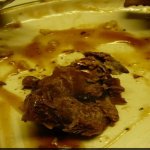In last 2 pages how much more subjective did we discuss and add? And how much of it off in the weeds? Almost 100%
The 'slow heavy preference' for less internal damage...slower dead formula. Unless high shoulder with the 405 cast from 45-70 at close range lol, hate to sound like a broken record but that same placement at the same animal at the same range will also bang flop with a 6.5 Grendel with 123's, a 6-Arc with 108's, a .223 with 77 gr tmk's and a ton of other cartridges but with the 45-70 option you're both sore after the shot. The 6.5 Creedmoor will drop them like that at 400 easy.
The 6.5 Creedmoor will drop them like that at 400 easy.
It's all relative, slow and heavy for what game and bullet intended? Each mans definition of this will be different. Ie; I prefer heavy for caliber slowed down to moderate velocities with rapid expansion type bullets. The goal being how to get the most of each grain of powder you burned into the animal you're chasing. Subjectively we've got some great formulas out there that we've stumbled upon. The .204 ruger 35 gr Berger is one of them for coyotes, might not be a more perfect match to study for those looking for the fastest dead formula. The fast 7's with 160 AB's sounds like another deadly combo for much larger bracket of game. Most of us live somewhere in between. Then there's Africa.
As this thread shows though, it's all reduced to subjective hearsay, hardly any numbers or objective data thrown out there and the stuff that is often used (ft/lbs energy) is the wrong data to use as this thread was started with.
I've been trying to open thy eyes that while yes we know intimately what's happening with that bullet the minute it leaves the barrel to the minute it lands on the target, no work left to do to understand this further and there's nothing subjective left about it. HOWEVER, when the swimming starts, from the hide to hide, we just blabber on subjectively and it eats up gobs of cyberspace. We are a quarter century behind on the terminal ballistics side (for hunting), we need to catch up, this is where the focus needs to be now.
Run the formula for the top combos we've learned about to get our baselines. Then we can compare and develop new against it. Energy is useless figure as it has always been talked about. We aren't looking at finished bullets. We aren't looking at the change in SD. We aren't looking at energy dumped inside the animal. There is a way to measure the hide to hide better and we keep trying to do it with perm stretch, temp stretch cavity blah blah...measuring the internal damage of an animal somehow when the bullet is completely ignored. The bullet doesn't change in-flight ballistics so we don't look at that, we use bc and atmospherics, well the animal is the atmospherics and sd is the bc from the hide onward, and most of our bullets change from the hide onward. Takes a different mindset and measures to objectify this. We keep going on about head stamps, diameters, and it's a dead horse smashing thing. And none of that explains the 6.5 mannlicher vs 700 nitro, the 416 vs 270 goat, the .204 35gr berger coyote etc. etc. We can do better, we need to do better.
I am getting shorter overall recoveries with a 6.5 Grendel with 123 gr eld-m's than I was getting with .270's and .270 wsm's running 140 accubonds on the same game and ranges I've always hunted. I'm burning a fraction of the powder I used to. There's an explanation for it and it's not in ft/lbs and it's not in headstamps, or diameters. There's an explanation for when doing acreage control coyotes with a .17 hmr that the 17 gr v-max or tnt are great for killing them on the acreage and the 20 gr xtp bullet is perfect for having them die on the neighbours acreage (ask me how I know ). Dead is dead, but it's a dynamic range, from instant dead to bleed out until no more O2 to the brain dead (bigger animals more blood takes longer for that same effect). Same cartridge with different bullets will give a range often from instant to the bleed out for most games intended, we do our best to match up to that. Most guys shoot way more than needed because it's such a subjective topic still, insurance is good. We can do better than that though, we're almost a quarter way through the 21st century.
). Dead is dead, but it's a dynamic range, from instant dead to bleed out until no more O2 to the brain dead (bigger animals more blood takes longer for that same effect). Same cartridge with different bullets will give a range often from instant to the bleed out for most games intended, we do our best to match up to that. Most guys shoot way more than needed because it's such a subjective topic still, insurance is good. We can do better than that though, we're almost a quarter way through the 21st century.
The 'slow heavy preference' for less internal damage...slower dead formula. Unless high shoulder with the 405 cast from 45-70 at close range lol, hate to sound like a broken record but that same placement at the same animal at the same range will also bang flop with a 6.5 Grendel with 123's, a 6-Arc with 108's, a .223 with 77 gr tmk's and a ton of other cartridges but with the 45-70 option you're both sore after the shot.
It's all relative, slow and heavy for what game and bullet intended? Each mans definition of this will be different. Ie; I prefer heavy for caliber slowed down to moderate velocities with rapid expansion type bullets. The goal being how to get the most of each grain of powder you burned into the animal you're chasing. Subjectively we've got some great formulas out there that we've stumbled upon. The .204 ruger 35 gr Berger is one of them for coyotes, might not be a more perfect match to study for those looking for the fastest dead formula. The fast 7's with 160 AB's sounds like another deadly combo for much larger bracket of game. Most of us live somewhere in between. Then there's Africa.
As this thread shows though, it's all reduced to subjective hearsay, hardly any numbers or objective data thrown out there and the stuff that is often used (ft/lbs energy) is the wrong data to use as this thread was started with.
I've been trying to open thy eyes that while yes we know intimately what's happening with that bullet the minute it leaves the barrel to the minute it lands on the target, no work left to do to understand this further and there's nothing subjective left about it. HOWEVER, when the swimming starts, from the hide to hide, we just blabber on subjectively and it eats up gobs of cyberspace. We are a quarter century behind on the terminal ballistics side (for hunting), we need to catch up, this is where the focus needs to be now.
Run the formula for the top combos we've learned about to get our baselines. Then we can compare and develop new against it. Energy is useless figure as it has always been talked about. We aren't looking at finished bullets. We aren't looking at the change in SD. We aren't looking at energy dumped inside the animal. There is a way to measure the hide to hide better and we keep trying to do it with perm stretch, temp stretch cavity blah blah...measuring the internal damage of an animal somehow when the bullet is completely ignored. The bullet doesn't change in-flight ballistics so we don't look at that, we use bc and atmospherics, well the animal is the atmospherics and sd is the bc from the hide onward, and most of our bullets change from the hide onward. Takes a different mindset and measures to objectify this. We keep going on about head stamps, diameters, and it's a dead horse smashing thing. And none of that explains the 6.5 mannlicher vs 700 nitro, the 416 vs 270 goat, the .204 35gr berger coyote etc. etc. We can do better, we need to do better.
I am getting shorter overall recoveries with a 6.5 Grendel with 123 gr eld-m's than I was getting with .270's and .270 wsm's running 140 accubonds on the same game and ranges I've always hunted. I'm burning a fraction of the powder I used to. There's an explanation for it and it's not in ft/lbs and it's not in headstamps, or diameters. There's an explanation for when doing acreage control coyotes with a .17 hmr that the 17 gr v-max or tnt are great for killing them on the acreage and the 20 gr xtp bullet is perfect for having them die on the neighbours acreage (ask me how I know











































































